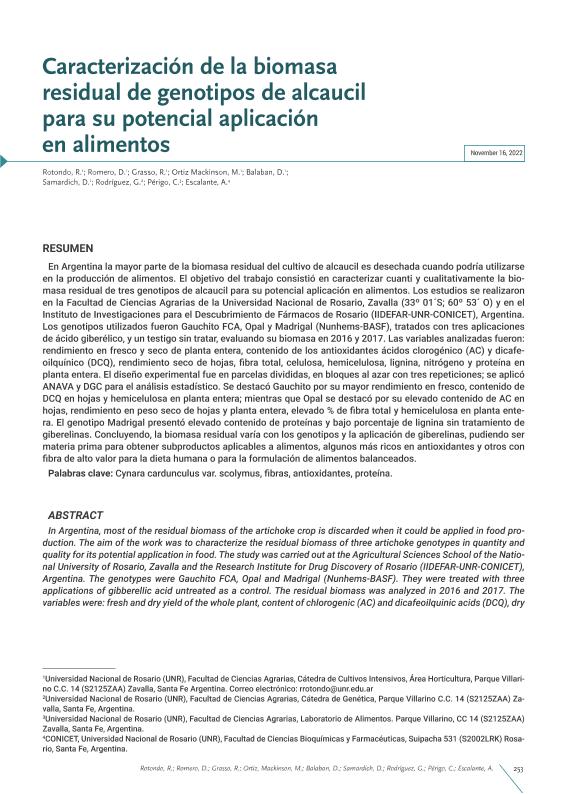Artículo
En Argentina la mayor parte de la biomasa residual del cultivo de alcaucil es desechada cuando podría utilizarse en la producción de alimentos. El objetivo del trabajo consistió en caracterizar cuanti y cualitativamente la biomasa residual de tres genotipos de alcaucil para su potencial aplicación en alimentos. Los estudios se realizaron en la Facultad de Ciencias Agrarias de la Universidad Nacional de Rosario, Zavalla (33º 01 ́S; 60º 53 ́ O) y en el Instituto de Investigaciones para el Descubrimiento de Fármacos de Rosario (IIDEFAR-UNR-CONICET), Argentina.Los genotipos utilizados fueron Gauchito FCA, Opal y Madrigal (Nunhems-BASF), tratados con tres aplicaciones de ácido giberélico, y un testigo sin tratar, evaluando su biomasa en 2016 y 2017. Las variables analizadas fueron: rendimiento en fresco y seco de planta entera, contenido de los antioxidantes ácidos clorogénico (AC) y Dicafeoilquínico (DCQ), rendimiento seco de hojas, fibra total, celulosa, hemicelulosa, lignina, nitrógeno y proteína en planta entera. El diseño experimental fue en parcelas divididas, en bloques al azar con tres repeticiones; se aplicó ANAVA y DGC para el análisis estadístico. Se destacó Gauchito por su mayor rendimiento en fresco, contenido de DCQ en hojas y hemicelulosa en planta entera; mientras que Opal se destacó por su elevado contenido de AC en hojas, rendimiento en peso seco de hojas y planta entera, elevado % de fibra total y hemicelulosa en planta entera. El genotipo Madrigal presentó elevado contenido de proteínas y bajo porcentaje de lignina sin tratamiento de giberelinas. Concluyendo, la biomasa residual varía con los genotipos y la aplicación de giberelinas, pudiendo ser materia prima para obtener subproductos aplicables a alimentos, algunos más ricos en antioxidantes y otros confibra de alto valor para la dieta humana o para la formulación de alimentos balanceados. In Argentina, most of the residual biomass of the artichoke crop is discarded when it could be applied in food production. The aim of the work was to characterize the residual biomass of three artichoke genotypes in quantity and quality for its potential application in food. The study was carried out at the Agricultural Sciences School of the National University of Rosario, Zavalla and the Research Institute for Drug Discovery of Rosario (IIDEFAR-UNR-CONICET), Argentina. The genotypes were Gauchito FCA, Opal and Madrigal (Nunhems-BASF). They were treated with three applications of gibberellic acid untreated as a control. The residual biomass was analyzed in 2016 and 2017. The variables were: fresh and dry yield of the whole plant, content of chlorogenic (AC) and dicafeoilquinic acids (DCQ), dry yield of leaves, total fiber, cellulose, hemicellulose, lignin, nitrogen and protein in the whole plant. The experimental design was insplit plots (genotypes in plots and GA treatment in subplots), in randomized blocks with three replications. The variables were analyzed by two way ANAVA and DGC used. Gauchito had highest values for yield in fresh, DCQ content in leaves and hemicellulose content in the whole plant. Opal stood out for the high AC content in leaves, dry weight yield in in leaves and whole plant; total fiber and hemicellulose in the whole plant. Madrigal had a high protein content and low % of lignin without gibberellin treatment. In conclusion, the residual biomass varies with the genotypes and the application of gibberellins, being able to be raw material to obtain by-products applicable to foods, some richer in antioxidants and others with high value fiber for the human diet or balanced formulations.
Caracterización de la biomasa residual de genotipos de alcaucil para su potencial aplicación en alimentos
Rotondo, Rosana; Romero, Daiana; Grasso, Rodolfo Oscar; Ortiz Mackinson, Mauricio Pablo; Balaban, David Mario ; Samardich, Diego; Rodríguez, Gustavo Rubén
; Samardich, Diego; Rodríguez, Gustavo Rubén ; Périgo, Carlos; Escalante, Andrea Marta
; Périgo, Carlos; Escalante, Andrea Marta
 ; Samardich, Diego; Rodríguez, Gustavo Rubén
; Samardich, Diego; Rodríguez, Gustavo Rubén ; Périgo, Carlos; Escalante, Andrea Marta
; Périgo, Carlos; Escalante, Andrea Marta
Fecha de publicación:
11/2022
Editorial:
Instituto Nacional de Tecnología Agropecuaria
Revista:
Revista de Investigaciones Agropecuarias
ISSN:
0325-8718
e-ISSN:
1669-2314
Idioma:
Español
Tipo de recurso:
Artículo publicado
Clasificación temática:
Resumen
Palabras clave:
CYNARA CARDUNCULUS VAR. SCOLYMUS
,
FIBRAS
,
ANTIOXIDANTES
,
PROTEÍNAS
Archivos asociados
Licencia
Identificadores
Colecciones
Articulos(IICAR)
Articulos de INST. DE INVESTIGACIONES EN CIENCIAS AGRARIAS DE ROSARIO
Articulos de INST. DE INVESTIGACIONES EN CIENCIAS AGRARIAS DE ROSARIO
Citación
Rotondo, Rosana; Romero, Daiana; Grasso, Rodolfo Oscar; Ortiz Mackinson, Mauricio Pablo; Balaban, David Mario; et al.; Caracterización de la biomasa residual de genotipos de alcaucil para su potencial aplicación en alimentos; Instituto Nacional de Tecnología Agropecuaria; Revista de Investigaciones Agropecuarias; 11-2022; 1-8
Compartir



